Analysis and Validation of Lightweight Carriage Structures Using Basalt Fiber Composites
Abstract
:1. Introduction
2. Design, Simulation, and Experimental Methods
2.1. Structural Design
2.2. Material Properties
2.3. Working Condition Settings
2.3.1. Working Condition 1: Static Condition
2.3.2. Working Condition 2: Dynamic Condition
- (1)
- Full-load start-up acceleration condition:
- (2)
- Full-load brake operating conditions:
- (3)
- Full-load turning condition:
- (4)
- Full-load cornering brake condition:
2.3.3. Working Condition 3: Impact Condition
2.4. FE Analysis
2.5. Experimental Design and Validation
3. Results & Discussion
3.1. Finite Element Results Analysis
3.2. Comparison and Validation of Experimental Results
4. Conclusions
- (1)
- A novel prefabricated dump truck carriage structure based on basalt fiber composites is proposed, effectively achieving the goal of being lightweight while meeting the stringent performance requirements for load-bearing capacity and strength in heavy-duty carriages. Key parameters of the basalt fiber composite were obtained through experiments, and the carriage was subjected to stress analysis under six different operating conditions to systematically evaluate its feasibility.
- (2)
- The maximum stress occurs in the reinforcing bar of the T700 metal frame under the full-load turning braking condition, with a value of 366.1 MPa. The maximum displacement of 3.73 mm occurs in the side panel during the full-load direction change condition. Both values meet design requirements, confirming the structural feasibility of the composite compartment.
- (3)
- By conducting bending resistance tests on the side panels subjected to greater forces and comparing the results with finite element analysis, an error of 11.1% was obtained, indicating a good consistency between the two and further validating the accuracy of the finite element analysis of the overall structure. The overall structure of the carriage can be further optimized for weight reduction through methods such as topology optimization. Additionally, incorporating vehicle test data under subsequent actual working conditions will provide strong support for further improvements to the finite element model.
Author Contributions
Funding
Data Availability Statement
Conflicts of Interest
References
- Woodrooffe, J. Opportunity Cost for Society Related to U.S. Truck Size and Weight Regulation: Freight Efficiency. Transp. Res. Record 2016, 2547, 25–31. [Google Scholar] [CrossRef]
- Phiri, R.; Mavinkere Rangappa, S.; Siengchin, S.; Oladijo, O.P.; Ozbakkaloglu, T. Advances in Lightweight Composite Structures and Manufacturing Technologies: A Comprehensive Review. Heliyon 2024, 10, e39661. [Google Scholar] [CrossRef] [PubMed]
- Lan, N.; Wang, Q.; Deutz, P. Chinese transport emissions reduction policies: Analysis of purchase intention and approaches to promote uptake of new energy construction dump trucks. J. Clean. Prod. 2024, 451, 142096. [Google Scholar] [CrossRef]
- Hagnell, M.K.; Kumaraswamy, S.; Nyman, T.; Åkermo, M. From aviation to automotive—A study on material selection and its implication on cost and weight efficient structural composite and sandwich designs. Heliyon 2020, 6, e03716. [Google Scholar] [CrossRef]
- Seyfried, P.; Taiss, E.J.M.; Calijorne, A.C.; Li, F.-P.; Song, Q.-F. Light weighting opportunities and material choice for commercial vehicle frame structures from a design point of view. Adv. Manuf. 2015, 3, 19–26. [Google Scholar] [CrossRef]
- Galos, J.; Sutcliffe, M. Material Selection and Structural Optimization for Lightweight Truck Trailer Design. SAE Int. J. Commer. Veh. 2020, 12, 281–297. [Google Scholar] [CrossRef]
- Wang, D.; Jiang, R.; Wu, Y. A hybrid method of modified NSGA-II and TOPSIS for lightweight design of parameterized passenger car sub-frame. J. Mech. Sci. Technol. 2016, 30, 4909–4917. [Google Scholar] [CrossRef]
- Zaripov, R.; Gavrilovs, P. Research Opportunities to Improve Technical and Economic Performance of Freight Car through the Introduction of Lightweight Materials in their Construction. Procedia Eng. 2017, 187, 22–29. [Google Scholar] [CrossRef]
- Ren, M.; Sun, T.; Shi, Y.; Zheng, S.; Li, Y. Lightweight optimization of vehicle frame structure based on the kriging approximate model. J. Mech. Strength 2019, 41, 1372–1377. [Google Scholar] [CrossRef]
- Mohrbacher, H.; Spöttl, M.; Paegle, J. Innovative manufacturing technology enabling light weighting with steel in commercial vehicles. Adv. Manuf. 2015, 3, 3–18. [Google Scholar] [CrossRef]
- Zhang, W.; Xu, J. Advanced lightweight materials for Automobiles: A review. Mater. Des. 2022, 221, 110994. [Google Scholar] [CrossRef]
- Chowdhury, I.R.; Pemberton, R.; Summerscales, J. Developments and Industrial Applications of Basalt Fibre Reinforced Composite Materials. J. Compos. Sci. 2022, 6, 367. [Google Scholar] [CrossRef]
- Pan, F.; Zhu, P.; Zhang, Y. Metamodel-based lightweight design of B-pillar with TWB structure via support vector regression. Comput. Struct. 2010, 88, 36–44. [Google Scholar] [CrossRef]
- Li, Y.; Lin, Z.; Jiang, A.; Chen, G. Experimental study of glass-fiber mat thermoplastic material impact properties and lightweight automobile body analysis. Mater. Des. 2004, 25, 579–585. [Google Scholar] [CrossRef]
- Singh, H.; Singh Brar, G.; Kumar, H.; Aggarwal, V. A review on metal matrix composite for automobile applications. Mater. Today: Proc. 2021, 43, 320–325. [Google Scholar] [CrossRef]
- ISO 527-4:2018; Plastics—Determination of Tensile Properties—Part 4: Test Conditions for Isotropic and Anisotropic Fibrous Composites. International Organization for Standardization: Geneva, Switzerland, 2018.
- Ram, K.; Gupta, M.; Kartikeya, K.; Khatkar, V.; Mahajan, P.; Bhatnagar, N. Performance analysis of fiber-reinforced polypropylene composite laminates under quasi-static and super-sonic shock loading conditions for impact application. J. Compos. Mater. 2024, 58, 1555–1570. [Google Scholar] [CrossRef]
- Wan, Q.; Ruan, J. Structural Optimization Design of a Dump Truck Cargo Compartment Based on Hybrid Sensitivity Analysis. Sci. Technol. Eng. 2020, 20, 4954–4961. [Google Scholar]
- Hu, D.; Chen, Y. Finite Element Analysis of the Strength of Electric Wheel Dump Truck Cargo Compartment. Intern. Combust. Engine Parts 2022, 10, 44–46. [Google Scholar] [CrossRef]
- Ren, X.; Wang, M.; Gao, Y. Strength Analysis of Mining Truck Cargo Compartment under Ore Impact Load. Constr. Mach. 2009, 40, 32–34+3. [Google Scholar]
- Hashin, Z. Failure Criteria for Unidirectional Fiber Composites. Journal of Applied Mechanics. 1980, 47, 329–334. [Google Scholar] [CrossRef]
- Hsieh, T.-H.; Wang, I.-H.; Huang, Y.-S.; Tsai, S.-N. Repairing damaged composite laminates using carbon fiber reinforced bulk mold compound. Mod. Phys. Lett. B 2023, 37, 2340029. [Google Scholar] [CrossRef]
- Alci, M.; Gunes, R. A comparison study on experimental characterization of unidirectional fiber reinforced composites using strain-gauges and virtual extensometers. Mater. Test. 2023, 65, 174–191. [Google Scholar] [CrossRef]
- Tuo, H.; Lu, Z.; Ma, X.; Xing, J.; Zhang, C. Damage and failure mechanism of thin composite laminates under low-velocity impact and compression-after-impact loading conditions. Compos. Part B Eng. 2019, 163, 642–654. [Google Scholar] [CrossRef]
- Maharshi, K.; Patel, S. Experimental and Numerical Analysis of Lightweight Hybrid Composites Under Low Velocity Impact. Appl. Compos. Mater. 2024, 31, 1393–1412. [Google Scholar] [CrossRef]



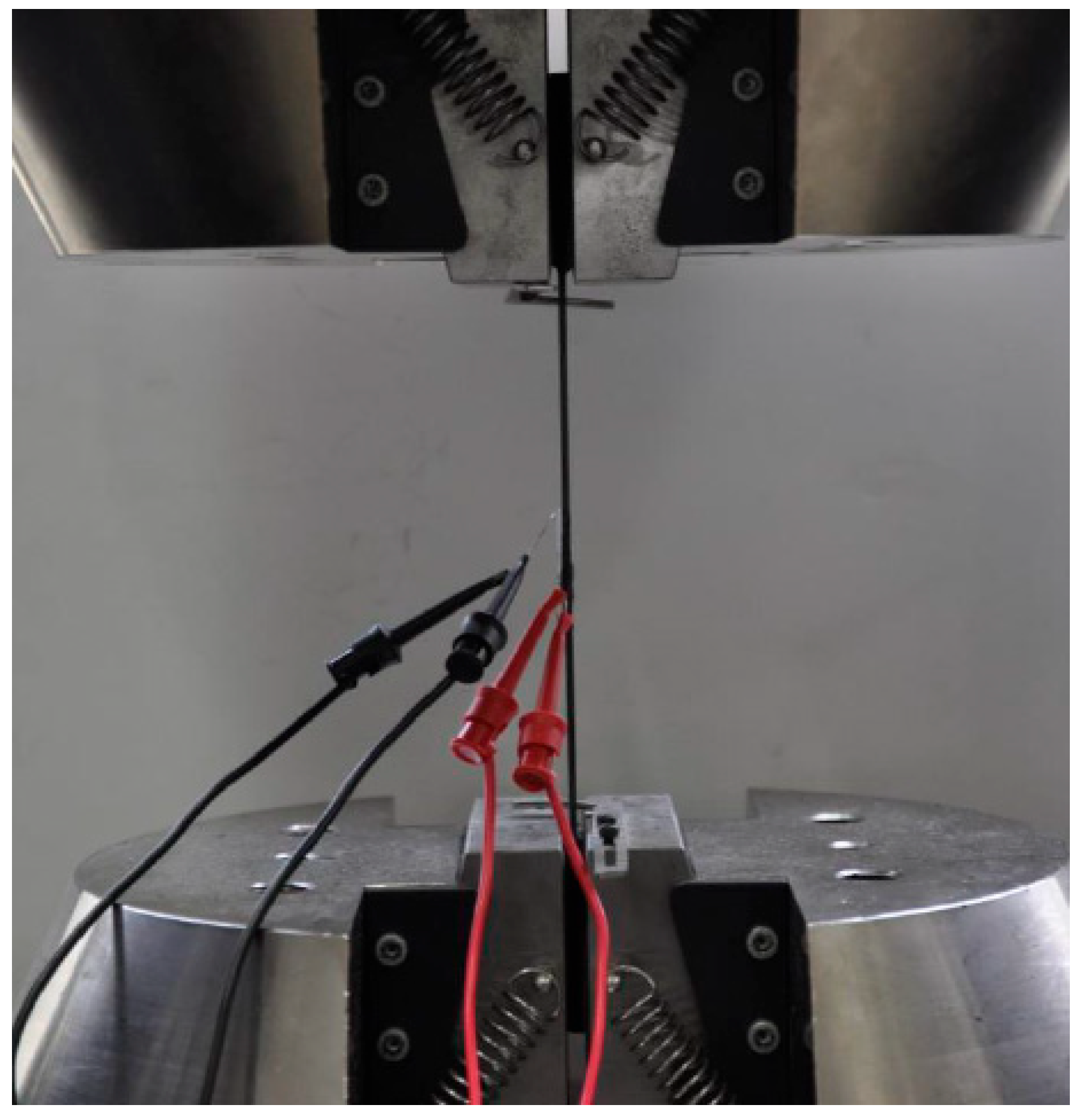
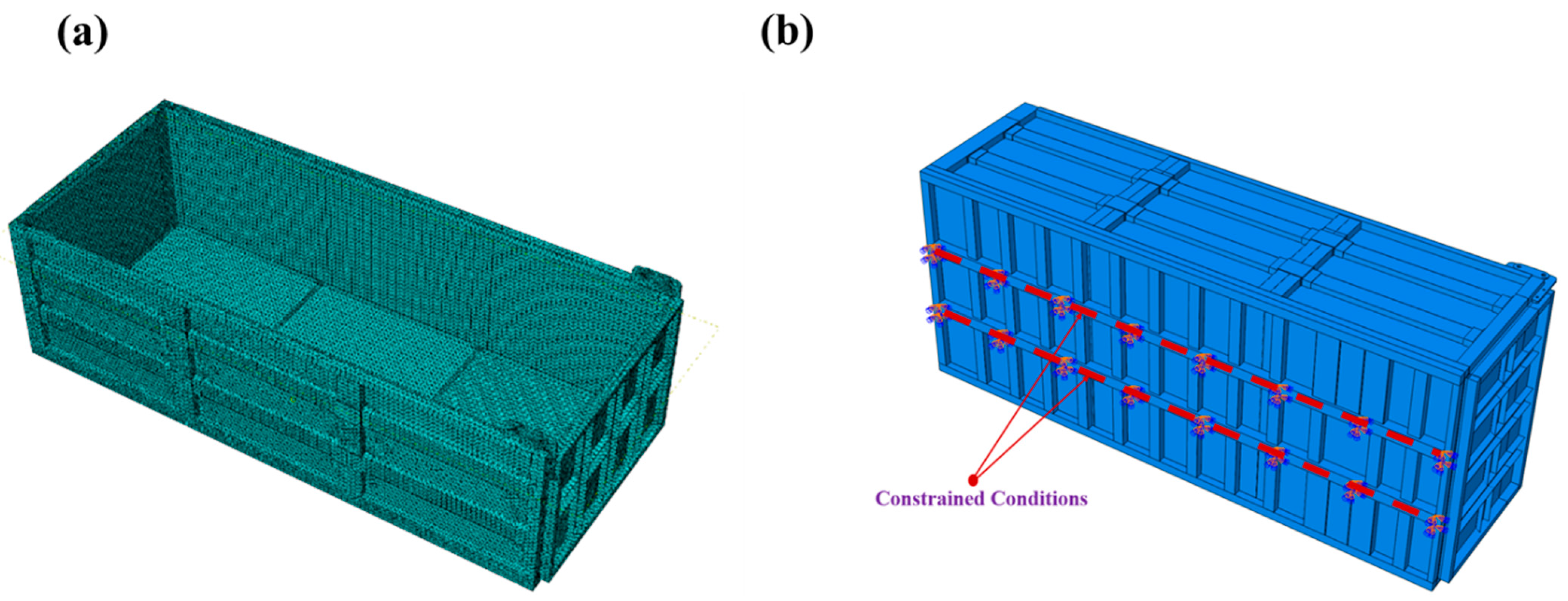
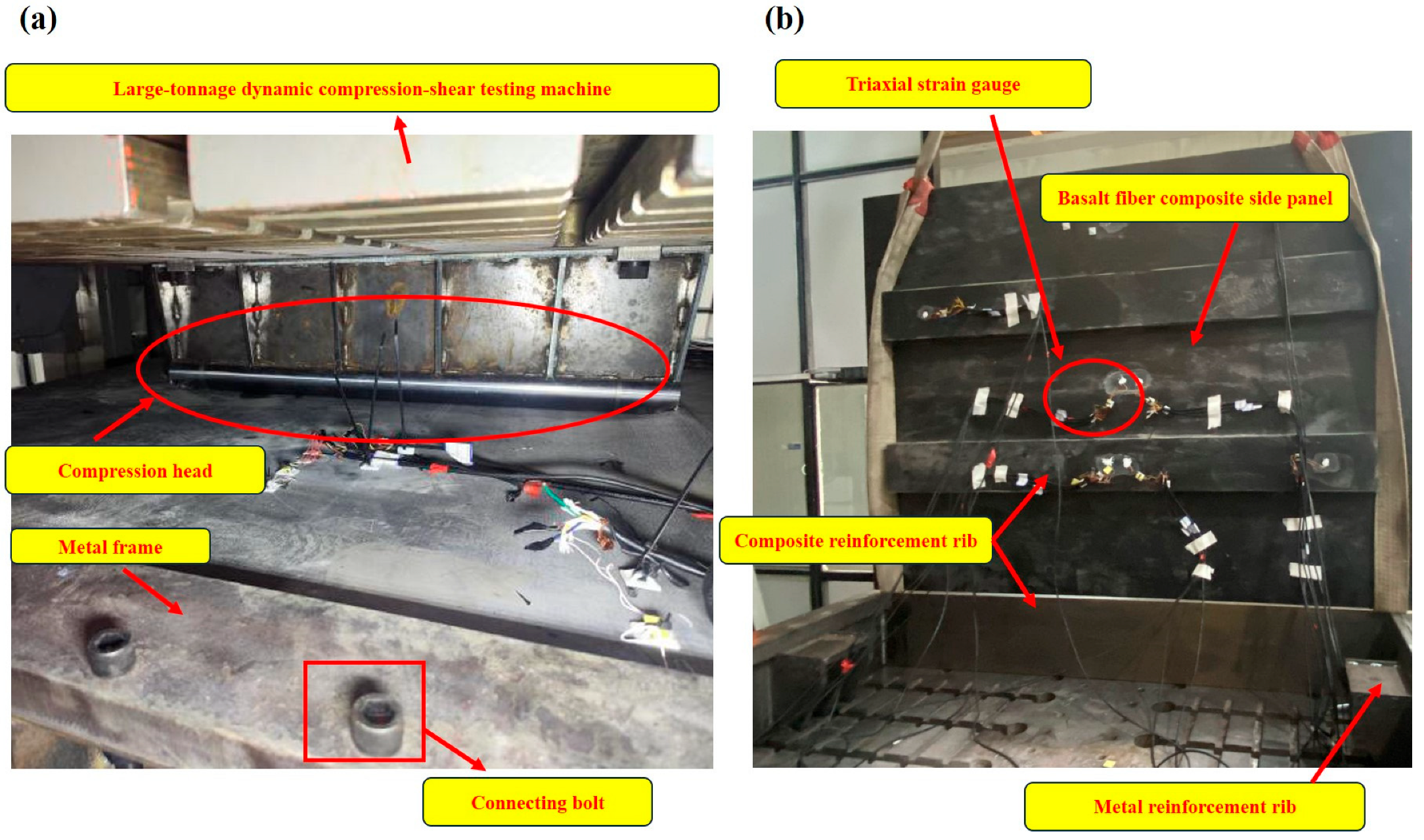
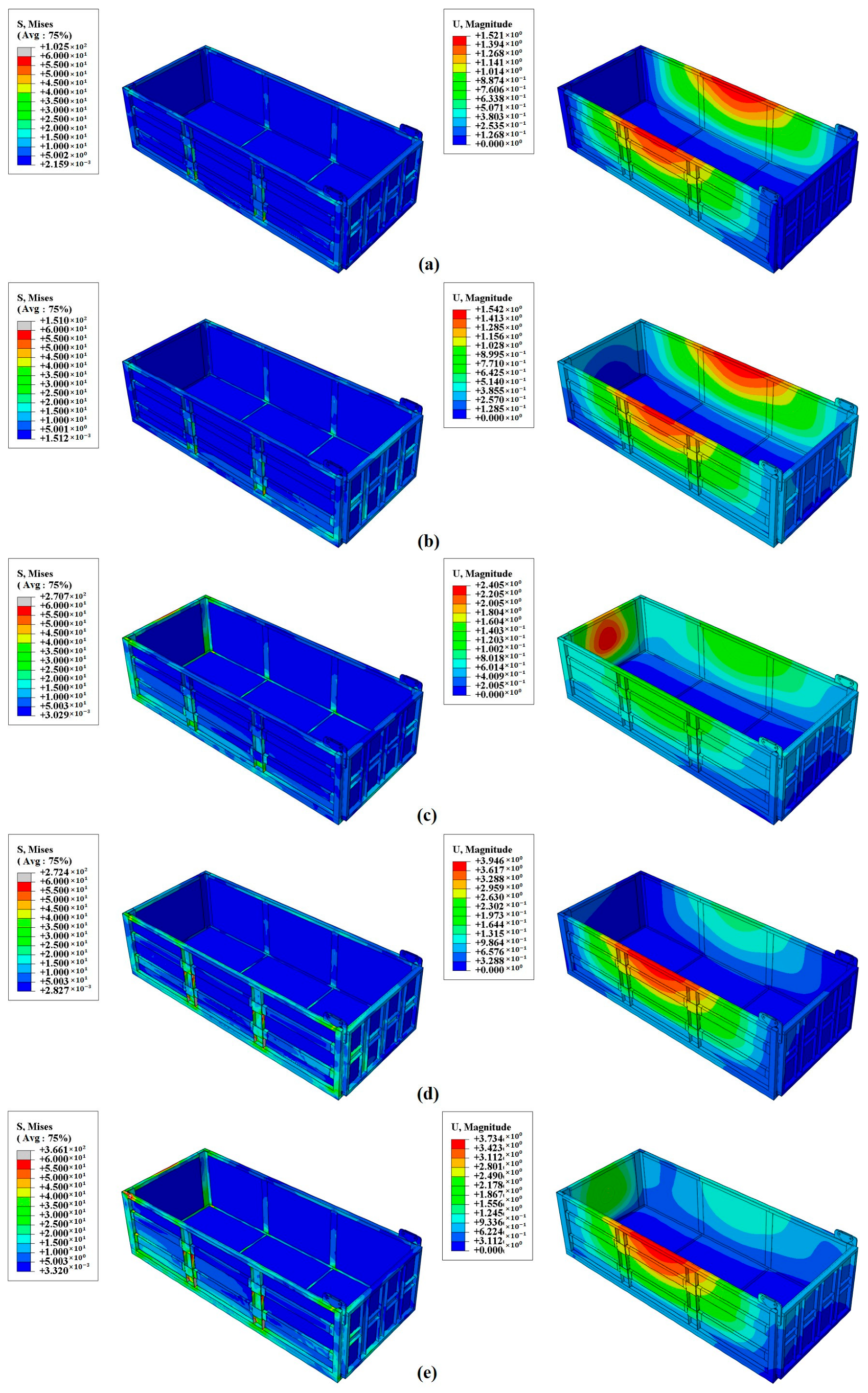



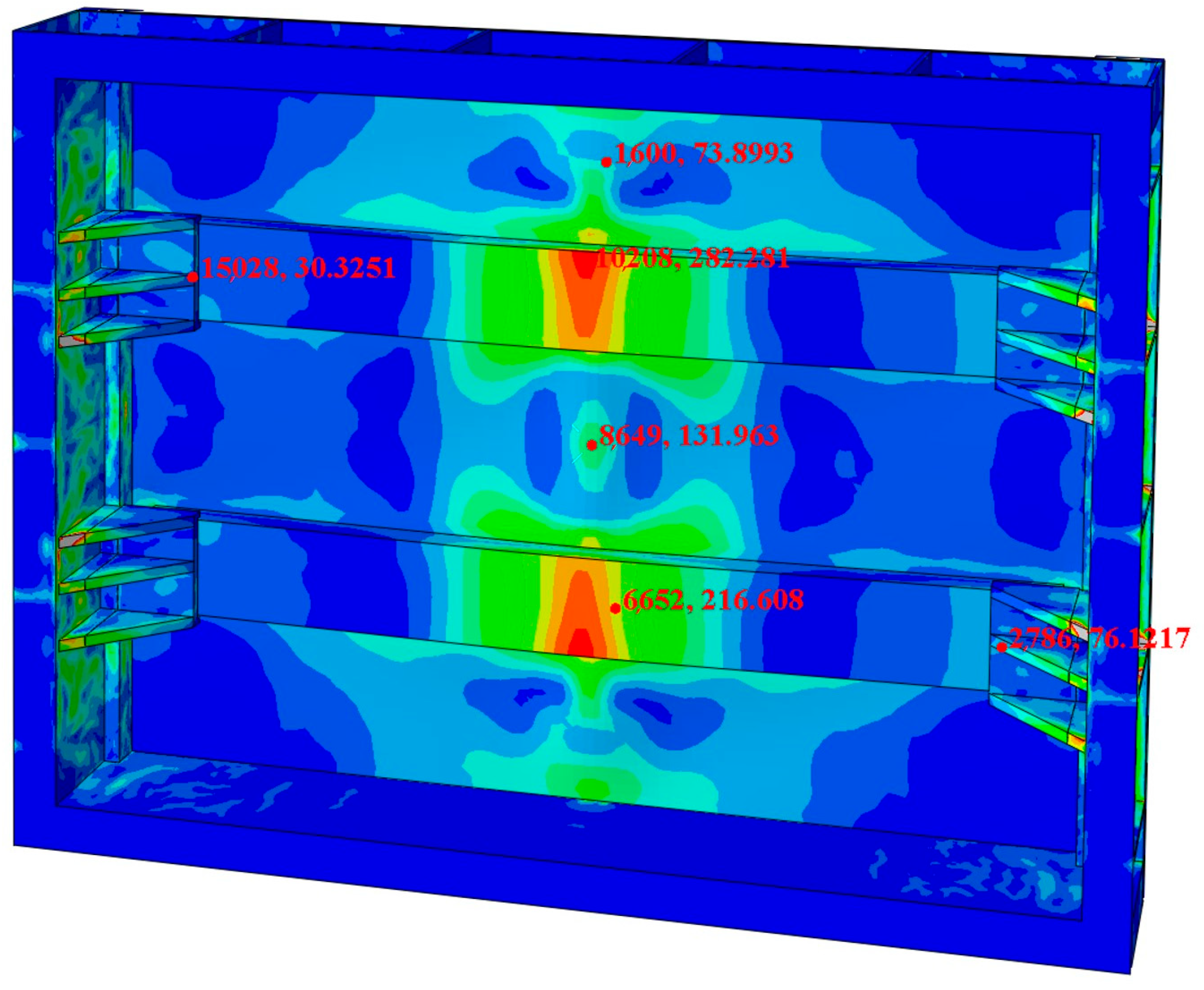
| NO. | b (mm) | H (mm) | (KN) | |||
|---|---|---|---|---|---|---|
| 01# | 25.06 | 2.261 | 57.26 | 1010.59 | 38.53 | 0.3 |
| 02# | 25.06 | 2.261 | 60.23 | 1063.06 | 36.99 | 0.3 |
| 03# | 25.06 | 2.261 | 57.67 | 1017.82 | 37.76 | 0.3 |
| Basalt fiber composite | 37.75 | 1039.28 | 0.3 |
| T700 | 169 | 700 | 0.305 |
| 0.05 | 194.8 |
| 0.1 | 203.9 |
| 0.15 | 222.1 |
| 0.2 | 232.6 |
| NO. | 1 | 2 | 3 | 4 | 5 | 6 |
|---|---|---|---|---|---|---|
| Test value (MPa) | 33.61 | 80.43 | 334.09 | 164.56 | 218.7 | 87.33 |
| FEA (MPa) | 30.33 | 73.90 | 282.28 | 131.96 | 216.61 | 76.12 |
| Error rate | 9.9% | 8.1% | 15.5% | 19.8% | 0.9% | 12.8% |
Disclaimer/Publisher’s Note: The statements, opinions and data contained in all publications are solely those of the individual author(s) and contributor(s) and not of MDPI and/or the editor(s). MDPI and/or the editor(s) disclaim responsibility for any injury to people or property resulting from any ideas, methods, instructions or products referred to in the content. |
© 2024 by the authors. Licensee MDPI, Basel, Switzerland. This article is an open access article distributed under the terms and conditions of the Creative Commons Attribution (CC BY) license (https://creativecommons.org/licenses/by/4.0/).
Share and Cite
Wang, X.; Yuan, S.; Sun, W.; Hao, W.; Zhang, X.; Yang, Z. Analysis and Validation of Lightweight Carriage Structures Using Basalt Fiber Composites. Materials 2024, 17, 5723. https://doi.org/10.3390/ma17235723
Wang X, Yuan S, Sun W, Hao W, Zhang X, Yang Z. Analysis and Validation of Lightweight Carriage Structures Using Basalt Fiber Composites. Materials. 2024; 17(23):5723. https://doi.org/10.3390/ma17235723
Chicago/Turabian StyleWang, Xianglin, Shaoqing Yuan, Wei Sun, Wenfeng Hao, Xufeng Zhang, and Zhongjia Yang. 2024. "Analysis and Validation of Lightweight Carriage Structures Using Basalt Fiber Composites" Materials 17, no. 23: 5723. https://doi.org/10.3390/ma17235723
APA StyleWang, X., Yuan, S., Sun, W., Hao, W., Zhang, X., & Yang, Z. (2024). Analysis and Validation of Lightweight Carriage Structures Using Basalt Fiber Composites. Materials, 17(23), 5723. https://doi.org/10.3390/ma17235723








